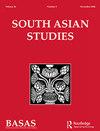Inferring Road Networks and Socio-Political Change through Elite Monuments of the Golconda Kingdom
IF 0.7
0 ASIAN STUDIES
引用次数: 2
Abstract
In the study of medieval and early modern South Asia, archaeologists, historians, and art historians have studied selected monuments in depth or surveyed regions for monumental ruins and other features, but have less commonly studied their datasets as a group to infer processes of socio-political change. Using the example of the Golconda kingdom of India’s Deccan plateau, this study describes the evidence of the kingdom’s physical presence across a wide area, and shows how by combining the distribution across space with evidence of changes over time, aspects of the kingdom’s socio-political evolution can be inferred, from the development of the capital to the kingdom’s changing relationship with its more distant peripheries. Some overlooked monuments, when placed in this context, critically suggest the early formative stages of central political authority; others point to a growing culture of elite wealth, patronage, and competition during the era of increased international trade.通过戈尔康达王国的精英纪念碑推断道路网络和社会政治变化
在对中世纪和早期现代南亚的研究中,考古学家、历史学家和艺术史学家对选定的纪念碑进行了深入研究,或对纪念性遗址和其他特征进行了调查,但很少将他们的数据集作为一个群体来推断社会政治变化的过程。本研究以印度德干高原的戈尔康达王国为例,描述了该王国在广泛地区的实际存在的证据,并展示了如何通过将跨空间分布与随时间变化的证据相结合,推断出该王国的社会政治演变的各个方面,从首都的发展到王国与其更遥远的外围地区不断变化的关系。一些被忽视的纪念碑,当放在这种背景下,批判性地暗示了中央政治权威的早期形成阶段;其他人则指出,在国际贸易日益增长的时代,精英财富、庇护和竞争的文化日益增长。
本文章由计算机程序翻译,如有差异,请以英文原文为准。
求助全文
约1分钟内获得全文
求助全文

 求助内容:
求助内容: 应助结果提醒方式:
应助结果提醒方式:


